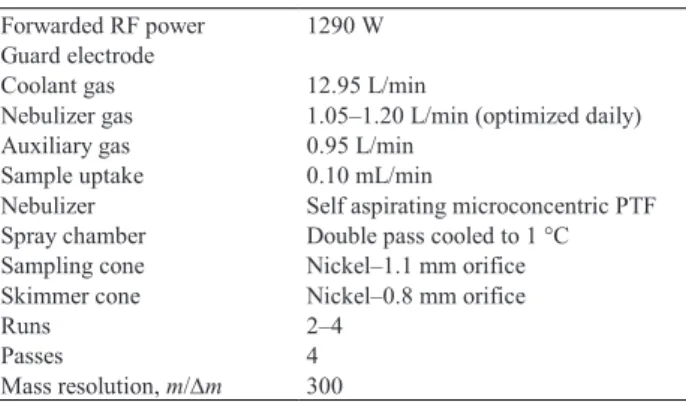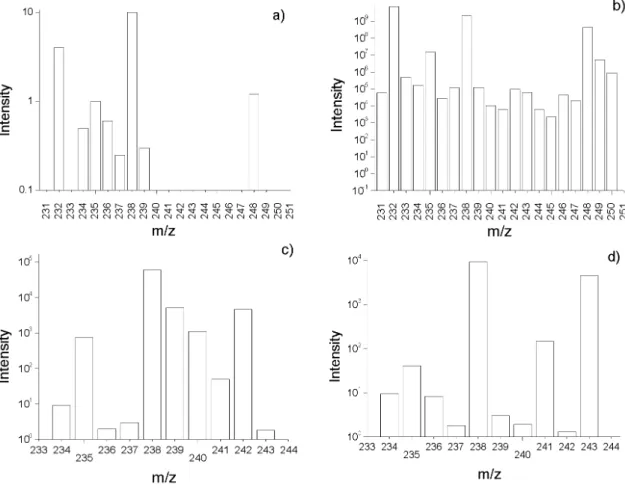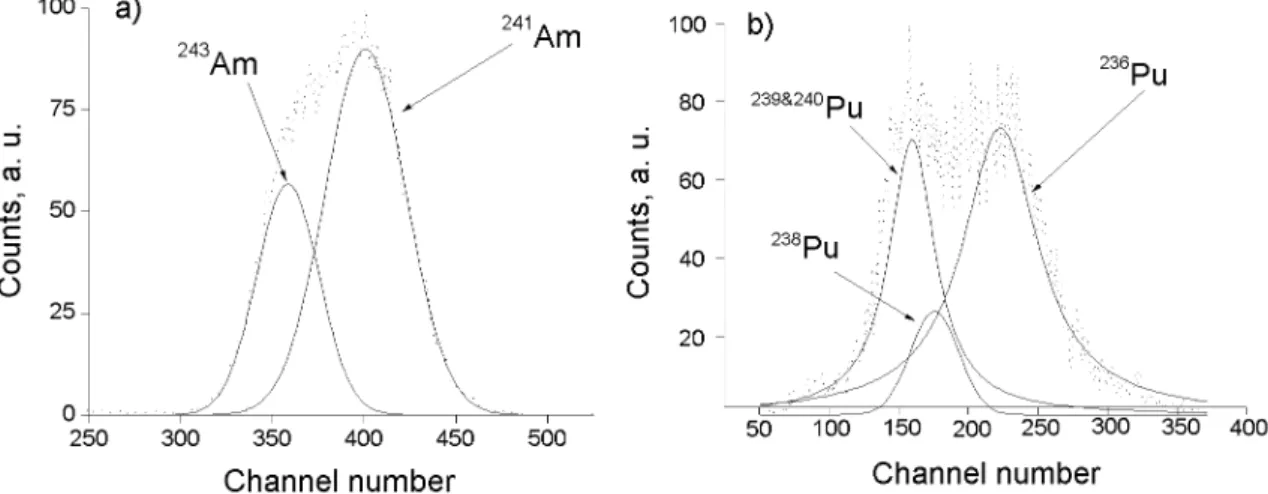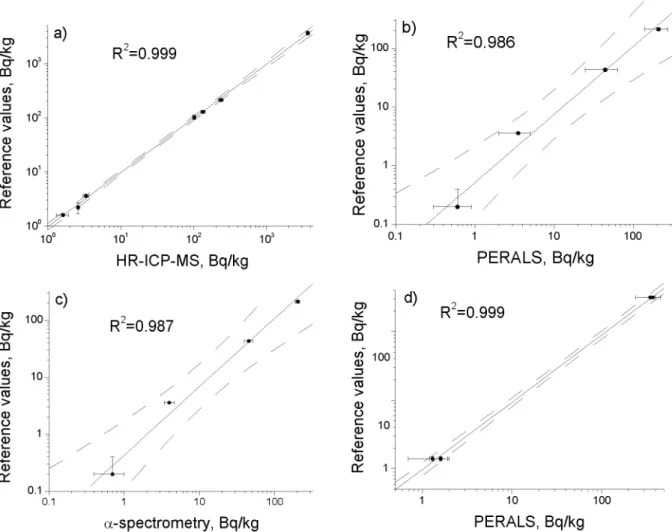Sensitivity of DF-ICP-MS, PERALS and alpha-spectrometry
for the determination of actinides: A comparison
M. Ayranov,1,2* U. Krähenbühl,1 S. Röllin,3 M. Burger3
1 Department for Chemistry and Biochemistry, University of Bern, Freiestrasse 3, CH-3012, Bern, Switzerland
2 Present address: European Commission, Joint Research Centre, Institute for Transuranium Elements, Postfach 2340, 76125 Karlsruhe, Germany 3 AC-Laboratory Spiez, Switzerland
(Received April 11, 2008)
We applied three techniques (DF-ICP-MS, PERALS and alpha-spectrometry) for the determination of minor actinides at environmental levels. For each method the limit of detection and the resolution were estimated in order to study the content and isotopic composition of the actinides. Two international reference materials, IAEA-135 (Irish Sea Sediment) and IAEA-300 (Baltic Sea sediment) were analyzed for activity concentrations of
238Pu, 239Pu, 240Pu, 241Pu and 241Am. The sensitivities of the three determination techniques were compared.
Introduction
The accurate and precise ultra-trace and isotopic analysis of the actinides in the environment is a subject of importance for health, control of illicit nuclear activities, nuclear waste managements, evaluation enrichment of radioactive isotopes caused by nuclear weapons testing and fallout from nuclear power plants or nuclear accidents, etc.1–4
The detection of low level activities of actinides (Th, U, Np, Pu, Am) can be performed by several methods. Among them are solid state alpha-spectrometry, neutron activation analysis (NAA), photon electron rejecting liquid alpha-spectroscopy (PERALS) and in the recent years inductively coupled plasma mass spectrometry (ICP-MS) and accelerator mass spectrometry (AMS).1,5– 12 Solid state alpha-spectrometry offers a sufficiently low limit of detection (108 atoms per sample) for nuclides with a half-life shorter than a thousand years and has an energy resolution of 15 to 25 keV.13 However, the method possesses a relatively low efficiency (20–25%), requires elaborated sample preparation and long counting time for the determination of low activity. NAA suffers of potential interferences, requires up to several days to complete preparation and the numbers of the facilities available are limited.14
PERALS is a relatively new method that combines chemical separation by liquid-liquid extraction and measurement of the alpha-activity in water-immiscible scintillators. This technique reduces the beta-gamma background by 99.9% and lowers the limit of detection by one order of magnitude in comparison to classical alpha-spectrometry. On the other side the poor energy resolution of the PERALS, 200–250 keV, requires selective chemistry in the sample preparation to isolate single elements. However the PERALS technique is sparsely used for the determination of actinides in
environmental samples whose matrix, as a rule, are complex and containing many quenching elements, e.g., heavy metals, phosphates, nitrates, organics etc.1,10
In many cases a very low limit of detection is required for the determination of the actinides in environmental samples; moreover, the half-lives of some nuclides of interest are long (e.g., 239Pu, 240Pu and 237Np). Alpha-spectrometry also does not provide information on 240Pu/239Pu ratio. The progresses in mass spectrometry in the last years led to lowering the detection limits to levels <fg/g.15 The method is appropriate for the determination of the concentration and isotope composition of the actinides. The technique is fast and compared to alpha-spectrometry suffer less interferences and does not need elaborated and costly sample preparation.16
To obtain the best results when determining the content of the actinides in the environmental samples, the analyst should consider the specificity of the sample material, to develop the optimal separation and preconcentration radiochemical procedures, the need of men power and the amount of waste generated as well as the particular requirements of the determination techniques, namely radiometric measurement and mass spectrometry.
The aim of this study was to evaluate the sensitivity, the resolution and the performance of three techniques, alpha-spectrometry, PERALS and DF-ICP-MS, for the determination of plutonium and americium at environmental levels in complex matrixes.
Experimental Instrumentation
An eight-channel Alpha Analyst, Canberra Inc. module with passivated ion-implanted planar silicone (PIPS) detectors of 600 mm2 active area was used for
M. AYRANOV et al.: SENSITIVITY OF DF-ICP-MS, PERALS AND ALPHA-SPECTROMETRY
the low level alpha-spectrometry. The sources for the alpha-spectrometry were prepared by electroplating on stainless steel disks from sulfate-based media.
Liquid scintillation alpha-spectrometry was performed by means of four PERALS® 8110 (ORDELA, Inc.) spectrometers connected to the Spectrum Master™ 920-8 – Ortec analog-digital converter (ADC) coupled to a PC system. Two water immiscible extractive scintillators were used to perform the liquid-liquid extraction: ALPHAEX, in which the extractive molecule is bis(2-ethylhexyl)phosphoric acid and POLEX containing tri-n-octylphosphine oxide as extractive molecule.
Double focusing high resolution inductively coupled plasma mass spectrometer (DF-ICP-MS) instrument (ELEMENT 2, Finnigan MAT, Bremen, Germany) was used for mass spectrometry measurements. The typical working conditions are presented in Table 1. The DF-ICP-MS system was optimized daily for maximal response of 1.2.106 cps for 238U using a standard solution with a concentration of 1 ng/g. A grounded guard electrode positioned between the load coil and the ICP torch attenuated the plasma potential and the molecular based interferences.11 In addition, it could improve the sensitivity of the system by a factor of 10.17 The effect of mass interferences from 238U+ and 238UH+ in the 239Pu region was determined for each batch of samples analyzed and was estimated to be 4.10–5. Analytical methodology
The analysis of the actinides requires their chemical separation from the matrix component as well as from each other. To develop the procedure for the determination of actinides in the present work we used a soil with a known content of natural uranium and thorium, spiked with standard solutions of 236Pu, 242Pu and 243Am. We used total sample digestion by borate fusion and a combination of liquid-liquid extraction and extraction chromatography for actinides separation. The detailed procedures for sample pre-treatment, chemical separation of the actinides and preparation of the samples for the measurements were published elsewhere.18,19 In order to validate the actinide determination methods two international reference materials, IAEA-13520 and IAEA-30021 were used.
Results and discussion
In Fig. 1 the following mass spectra are presented: blank sample (a), digested soil before the separation of
the actinides (b), the plutonium fraction from the IAEA-135 reference material (c), and the americium fraction from the IAEA-135 reference material (d). We observed relatively high intensities for the blank sample (Fig. 1a) at the masses of 232Th and 238U. The obvious reason in the sample pre-treatment was fusion. In spite of the fact that we used a fluxing agent with high purity, it contributed to some 50% of the counts in the blank sample. The mass spectrum of the sample solution prior to chemical separation is shown in Fig. 1b. All the masses in the region 231–250 amu are strongly influenced by the matrix elements isobaric and polyatomic interferences. The intensity of 238U is about 9.109, while the abundance sensitivities for masses between 237 amu and 239 amu are 10–5 and 4.10–5, respectively. The formation of 238UH+ influences severely the 239Pu mass. The nuclides of interest (239Pu, 240Pu, 241Pu, 242Pu, 241Am, and 243Am) showed intensities in the range of 104–105, which are not sufficient for their determination. The mass spectra after chemical separation of plutonium and americium are presented in Figs 1c and 1d, respectively. The decontamination factors for the chemical separation procedure of plutonium and americium from uranium were 105 and 106, respectively, and 104 and 106 for the separation from thorium. These values in combination with the sufficiently low abundance sensitivity made the determination of plutonium and americium isotopes possible.
The typical spectra of americium and plutonium obtained by PIPS detectors are presented in Fig. 2. The energy resolution is better than 25 keV and the separation of the nuclides determined from the yield tracers is possible. This is not the case with 239Pu (5.156 MeV) and 240Pu (5.168 MeV); here the energy resolution is not sufficient to separate these nuclides.
Table 1. Instrumental parameters of the DF-ICP-MS for the determination of actinide concentrations and isotopic composition Forwarded RF power 1290 W
Guard electrode
Coolant gas 12.95 L/min
Nebulizer gas 1.05–1.20 L/min (optimized daily) Auxiliary gas 0.95 L/min
Sample uptake 0.10 mL/min
Nebulizer Self aspirating microconcentric PTF Spray chamber Double pass cooled to 1 °C Sampling cone Nickel–1.1 mm orifice Skimmer cone Nickel–0.8 mm orifice Runs 2–4 Passes 4 Mass resolution, m/∆m 300
Fig. 1. Mass spectra of: (a) blank sample; (b) digested soil before the separation of the actinides; (c) 239Pu, 240Pu, 241Pu
and the yield tracer 242Pu in the reference material IAEA-135; (d) 241Am and the yield tracer 243Am in the reference material IAEA-135
Fig. 2. Alpha-spectra of 241Am, 243Am (a) and of plutonium in the reference material IAEA-135 (b).
The yield tracers 243Am and double spike with 236Pu and 242Pu were added to the reference material
The PERALS spectra of americium and plutonium isotopes presented in Fig. 3 show an energy resolution from 250 keV to 400 keV. These values are not enough
was performed by deconvolution of the complex spectrum and integration of every single peak.22 The data obtained were in satisfactory agreement to the one
M. AYRANOV et al.: SENSITIVITY OF DF-ICP-MS, PERALS AND ALPHA-SPECTROMETRY
Fig. 3. PERALS spectra of 241Am in the IAEA-135 reference material and yield tracer 243Am (a), and 239&240Pu, 238Pu
and the yield tracer 236Pu in the reference material IAEA-135 (b)
Table 2. Limits of detection (in Bq/kg) for 2 grams of sample material Nuclide HR-ICP-MS Alpha-spectrometrya,b PERALSa,b
239Pu 0.03 0.04 0.01 240Pu 0.09 241Pu 3.4 – – 242Pu 0.001 0.04 0.01 241Am 1.1 0.05 0.01 243Am 0.07 0.09 0.01
a Obtained for counting time 600000 seconds. b239Pu and 240Pu activities are presented as a sum.
Limits of detection
The ICP-MS detection limit was estimated using the METHOD 6020 approach23 recommended by EPA.
The limit of detections LD, Bq.kg–1, for PERALS and alpha-spectrometry were calculated for each particular sample using the Currie’s formula:24
t Y m B LD ⋅ ⋅ ⋅ + = η 66 . 4 71 . 2 (1)
where B is the blank counts, cps; η is the detector counting efficiency; m is the sample mass, kg; Y is the chemical yield, t is the time, s.
The results for the limits of detection estimated for 2 grams of sample material are presented in Table 2. The results show that for the nuclides with the longest
half-lives, i.e., 242Pu the ICP-MS surpasses by far the
detection limit of alpha-spectrometry and PERALS. For the actinides with half-lives in the range of 103–104 years all the methods have similar limits of detection. The differences among the limits of detection are mostly due to interferences such as with 238UH+ and 204Pb35Cl+ for ICP-MS and to the different yields from electroplating and extraction for the radiometric
methods. For the actinides with half-lifes shorter than 500 years the limit of detection of the radiometric determination method is better than the one of ICP-MS. Comparison of the results obtained
by DF-ICP-MS, alpha spectrometry and PERALS The results for plutonium and americium analyses obtained by DF-ICP-MS, alpha-spectrometry and PERALS for the international reference materials
IAEA-135 and IAEA-300 are in very good agreement (R2
values are between 0.986 and 0.999 for the confidence interval 95%) (Fig. 4). However, at the same time, the results for plutonium from DF-ICP-MS were higher than the indicated values by up to 10% mostly due to the isobaric interferences with 238U and 238UH+.
The values obtained for 241Am in the reference
material IAEA-135 are significantly higher (up to 20% compared to the reference values) for all three methods. The obvious reason is the 241Pu decay, which generated 241Am from the reference date.19,25
Conclusions
Solid state alpha-spectrometry is an appropriate technique for the determination of actinides, with a good sensitivity for the nuclides with half-lives shorter than 500 years. Nevertheless, it needs long counting time for low activity samples and the energy resolution for 239Pu
and 240Pu ratio determination is not sufficient. When
extraction chromatography is used for separations it may be necessary to get rid of all organic material that could have been stripped from the column with the sample. Organic compounds, particularly chelating agents, can significantly reduce the plating yield.
Fig. 4. Plutonium data obtained by HR-ICP-MS (a), PERALS (b), α-spectrometry (c) and americium activity (d) determined by PERALS, compared with the reference values in IAEA-135 and IAEA-300
The PERALS technique is useful in the analyses of variety of nonroutine samples demonstrating to be flexible and robust. It eliminates a lot of the complex chemical separation and does not require highly trained personal. Another important advantage of the method is an order of magnitude better sensitivity for determination of low activities of the major alpha-emitters compared to alpha-spectrometry. The analytical procedure we have applied for determination of actinides in variety complex environmental matrixes such as soils and sediments. The main drawback of the method is its poor energy resolution. In most of the real samples a deconvolution of the spectrum is required. This approach solves the overlapped peaks, but increases the uncertainty up to 30–35%.
DF-ICP-MS has proven to be a powerful tool for the determination of environmental levels of actinides. It
the other hand ICP-MS is a fast multi-element technique with high sensitivity for nuclides with long half-life, therefore, it will be the most used method in the future for the determination of actinides in the environment.
References
1. N. DACHEUX, J. AUPIAIS, Anal. Chem., 69 (1997) 2275.
2. W. J. MCDOWELL, Nuclear Science Series on Radiochemical Techniques, NAS-NS 3116, U.S. Government Printing Office, Washington, DC, 1986.
3. J. R. CADIEUX, SC. H. REBOUL, Radioact. Radiochem., 7 (1996) 30.
4. J. A. MCLEAN, J. S. BECKER, S. F. BOULYGA, H.-J. DIETZE, A. MONTASER, Inter. J. Mass Spectrom., 208 (2001) 193. 5. R. WEBER, R. A. ESTERLUND, P. PATZELT, Appl. Radiation
M. AYRANOV et al.: SENSITIVITY OF DF-ICP-MS, PERALS AND ALPHA-SPECTROMETRY
8. J. EIKENBERG, I. GÜNTHER, H. BEER, P. FROIDEVAUX, Determination of fallout 238Pu, 239Pu, 240Pu and 241Am soil
samples from Switzerland using high resolution alpha spectrometry and MC-ICP-MS, in: Advances in Nuclear and Radiochemistry, S. M. QAIM, H. H. COENEN (Eds), Extended Abstracts of the Papers Presented at the 6th Intern. Conf. on Nuclear and Radiochemistry NRC-6, Aachen, Germany, 2004. 9. N. DACHEUX, J. AUPIAIS, O. COURSON, C. AUBERT, Anal. Chem.,
72 (2000) 3150.
10. W. J. MCDOWELL, B. L. MCDOWELL, Liquid Scintillation Alpha Spectrometry, CRC Press Inc., Boca Raton, 1994.
11. A. MONTASER (Ed.), Inductively Coupled Plasma Mass Spectrometry, Wiley-VCH, New York, 1998.
12. L. K. FIFIELD, Nucl. Instr. Meth. Phys. Res., B172 (2000) 134. 13. C. A. LUSKUS, J. Radioanal. Nucl. Chem., 234 (1998) 287. 14. D. E. VANCE, V. F. BELT, T. J. OATTS, D. K. MANN, J. Radioanal.
Nucl. Chem., 234 (1998) 143.
15. L. WACKER, U. KRÄHENBÜHL, B. EICHLER, Radiochim. Acta, 90 (2002) 133.
16. J. B. TRUSCOTT, P. JONES, B. E. FAIRMAN, E. H. EVANS, Anal. Chim. Acta, 433 (2001) 245.
17. N. WIEDERIN, M. HAMERSTER, Order-of-magnitude improvement in sector-field ICP-MS using a Pt guard electrode. Presented at the 1998 Winter Conference on Plasma Spectrochemistry, Scottsdale, FP 40, 1998.
18. M. AYRANOV, L. WACKER., U. KRÄHENBÜHL, Radiochim. Acta, 90 (2002) 199.
19. M. AYRANOV, U. KRÄHENBÜHL, H. SAHLI, S. RÖLLIN, M. BURGER, Radiochim. Acta, 93 (2005) 249.
20. S. BALLESTRA, J. GASTAUD, J. J. LOPEZ, P. PARSI, D. VAS, Report on the intercomparison run IAEA-135 – Radionuclides in Irish Sea Sediment, IAEA/AL/063, International Atomic Energy Agency, Monaco, 1993.
21. S. BALLESTRA, J. GASTAUD, J. J. LOPEZ, P. PARSI, D. VAS, Report on the intercomparison run IAEA-300 – Radionuclides in Marine Sediment, IAEA/AL/064, International Atomic Energy Agency, Monaco, 1994.
22. J. AUPIAIS, Radiochim. Acta, 92 (2004) 125.
23. EPA Method 6020, Inductively Coupled Plasma Mass Spectrometry, Revision 0, 1994.
24. L. A. CURRIE, Anal. Chem., 40 (1968) 586.
25. J. MORENO, J. J. LAROSA, P. R. DANESI, K. BURNS, P. DEREGGE, N. VAJDA, M. SINOJMERI, Radioact. Radiochem., 9 (1998) 35.



